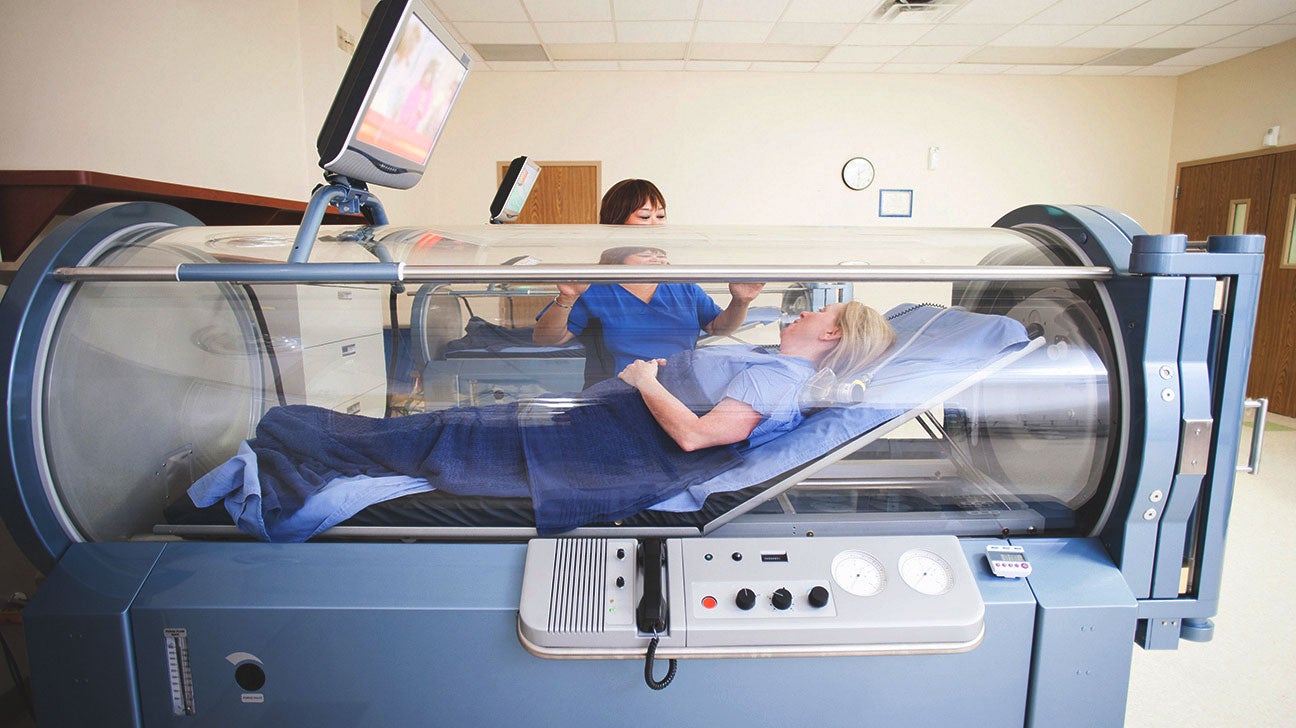What Is Hyperbaric Oxygen Therapy (HBOT)?
Hyperbaric Oxygen Therapy (HBOT) is a cutting-edge medical treatment where patients breathe 100% pure oxygen in a pressurized chamber. This controlled environment significantly increases oxygen levels in the blood, supercharging the body’s natural healing mechanisms. Originally used for decompression sickness in divers, HBOT has since gained recognition for its broad spectrum of applications—from wound healing to anti-aging therapies.
Accelerated Wound Healing: Oxygen as Medicine
Chronic wounds such as diabetic foot ulcers, pressure sores, and radiation injuries respond exceptionally well to HBOT. By delivering higher oxygen concentrations to affected tissues, the therapy stimulates:
Angiogenesis (formation of new blood vessels)
Fibroblast activity and collagen synthesis
White blood cell efficiency in fighting infection
Reduction of inflammation and edema
In clinical studies, HBOT has demonstrated up to 70% faster healing in non-healing wounds. Its inclusion in wound care protocols has drastically reduced amputation risks, especially among diabetic patients.
Hyperbaric Oxygen Therapy and Anti-Aging: A Cellular Perspective
The pursuit of youth has taken a scientific turn with HBOT. Research shows that hyperbaric oxygen sessions can reverse biological aging markers. This happens through:
Increased telomere length, associated with longevity
Reduction in senescent (aging) cells
Enhanced mitochondrial function
By boosting oxygen delivery at the cellular level, HBOT enhances skin elasticity, reduces fine lines, and improves overall skin tone. The therapy stimulates collagen production, making it a favorite among wellness clinics and anti-aging specialists.
Neurological Benefits: Rewiring the Brain with Oxygen
HBOT shows immense promise in neurological rehabilitation, including:
Stroke recovery
Traumatic Brain Injury (TBI)
Cerebral palsy
Post-concussion syndrome
The brain, though only 2% of the body’s mass, consumes over 20% of its oxygen. When supplied with more oxygen via HBOT, neuronal repair mechanisms activate, inflammation subsides, and neuroplasticity increases. Patients report improved memory, clarity, focus, and cognitive performance post-therapy.
Boosting Immune Function and Fighting Infections
HBOT enhances immune defense mechanisms by:
Stimulating leukocyte activity
Supporting the action of antibiotics
Creating an inhospitable environment for anaerobic bacteria
It is an approved adjunct treatment for conditions like gas gangrene, necrotizing infections, and osteomyelitis. The pressurized oxygen improves immune cell mobility and their ability to kill pathogens, making HBOT vital in managing chronic infections and sepsis.
Pain and Inflammation Relief: A Natural Anti-Inflammatory Solution
For those suffering from autoimmune conditions, chronic pain syndromes, or arthritis, HBOT provides noticeable relief. The high-oxygen environment reduces:
Pro-inflammatory cytokines
Oxidative stress
Tissue hypoxia
Patients with fibromyalgia and rheumatoid arthritis report significant pain relief and improved quality of life. It’s a natural alternative or complement to pharmacological interventions.
Enhancing Athletic Recovery and Performance
Top-tier athletes now use HBOT for muscle recovery, injury rehabilitation, and performance optimization. Key benefits include:
Reduced muscle soreness
Faster recovery from sprains, strains, and fractures
Enhanced red blood cell function
Improved VO2 max
Oxygen-rich blood reaches damaged tissues quicker, accelerating healing and reducing downtime. This makes HBOT a critical tool for sports physiologists and recovery centers.
Support for Cancer Patients During Radiation and Chemotherapy
HBOT is FDA-approved for radiation tissue damage, also known as radiation necrosis. It supports cancer patients by:
Repairing irradiated tissues
Reducing pain and fibrosis
Improving quality of life post-treatment
Additionally, the oxygen-rich environment enhances the effects of some chemotherapy agents and may help sensitize tumors to radiation—though this requires specialist guidance.
Hyperbaric Oxygen Therapy for Cosmetic and Skin Health
Many wellness spas and dermatology clinics now offer HBOT as a premium service for:
Skin rejuvenation
Reduction of wrinkles and hyperpigmentation
Post-surgical healing
Acne and rosacea improvement
By increasing circulation and reducing toxins, HBOT brightens the complexion, reduces scarring, and enhances skin resilience to external stressors.
Mental Health and Emotional Wellbeing
Emerging research links HBOT with improvements in mental health, particularly:
Post-Traumatic Stress Disorder (PTSD)
Anxiety and depression
Fatigue and burnout
The therapy modulates neurotransmitter activity, enhances brain oxygenation, and has been linked to elevated mood, better sleep, and enhanced mental resilience.
Safety, Sessions, and What to Expect
A standard HBOT session lasts 60 to 90 minutes, typically within a monoplace or multiplace chamber. Most individuals require 20–40 sessions depending on the condition.
Side effects are rare, but may include:
Temporary ear pressure
Mild claustrophobia
Oxygen toxicity (with extremely prolonged exposure)
All sessions are supervised by trained professionals, ensuring maximum safety and efficacy.
Conditions Treated with Hyperbaric Oxygen Therapy
The FDA and other global health authorities recognize HBOT for multiple indications:
Carbon monoxide poisoning
Decompression sickness
Crush injuries
Thermal burns
Compromised skin grafts and flaps
Sudden vision or hearing loss (off-label)
The therapy is also used off-label for Lyme disease, chronic fatigue syndrome, multiple sclerosis, and more.
Conclusion: Breathing New Life Into Modern Medicine
Hyperbaric Oxygen Therapy is no longer just an experimental frontier. It is a scientifically validated, versatile medical treatment with broad-spectrum applications—from wound care and recovery to cosmetic rejuvenation and neurological regeneration. As oxygen continues to be rediscovered as a powerful healing agent, HBOT stands at the forefront of modern regenerative medicine.



Comments
Post a Comment